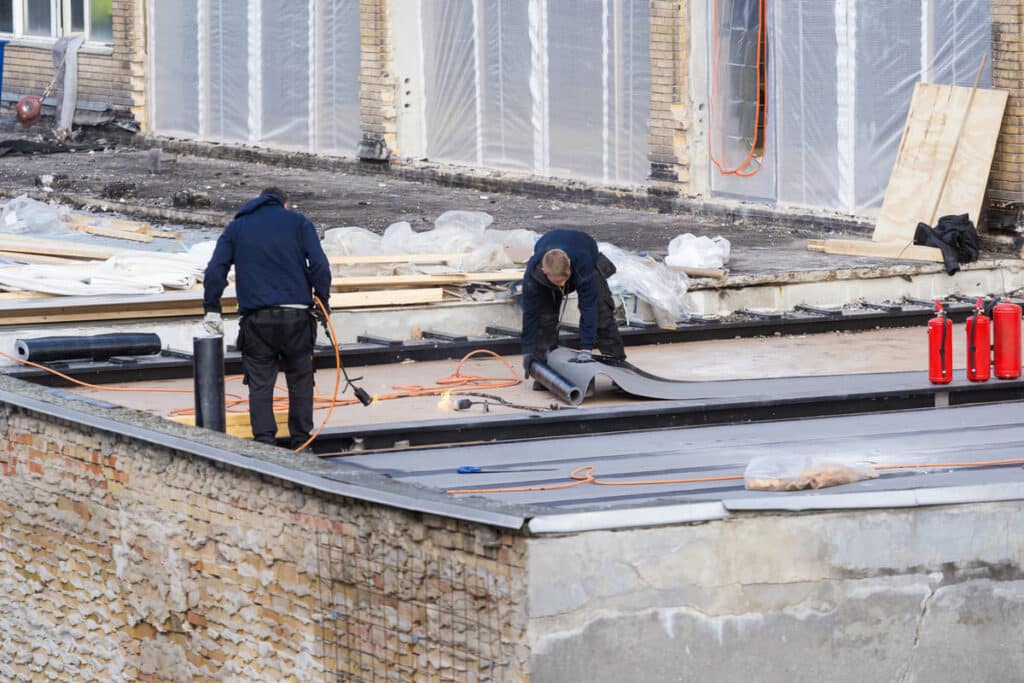Rubber roofing is an ideal choice for \Massachusetts homes and business owners, and at Beantown Home Improvement, we know exactly how to install it. If you’re interested in affordable roofing that’s basically waterproof as long as it’s properly maintained, you’ve come to the right place.
Understanding EPDM Rubber Roofing: The Foundation of Modern Flat Roof Solutions

Low-slope or flat roof materials made from rubber are also known as EPDM roofs. EPDM means ethylene propylene diene monomer. It’s a membrane crafted from synthetic rubber. This type of roof covering is made in big sheets or rolls, and it’s available in different thicknesses. The options are 30, 45, 60, and 100 mil. Most commonly, our customers select 45, 60, or 90 mil (0.045 to 0.090 inches). What they choose depends on what the roof’s going to be used for, their budget, and how exposed the home or business is.
There are some factors that make this type of roofing unique, such as its superb flexibility (it won’t break down in temperatures from -40°F to 300°F), its hardiness in extreme weather. It’s a roof covering that fits the single-ply roofing membrane category.
In the commercial roofing niche, EPDM reigns supreme. 60% of commercial roofing customers chose this material in 2023. Overall, this material grabs 30% of the roofing market share in America. Sheets of EPDM are produced that range in size from 7.5 to 50 feet in width. Lengths vary from 50 to 200 feet. A billion square feet of new roof coverings are added each year in the USA.
Why Rubber Roofing Excels on Flat and Low-Slope Roofs

Flat roofs are different from pitched roofs, as they don’t naturally drain away water the way that roofs with higher slopes do. In general, flat roofs have slopes ranging from 1/4-inch to 3 inches per foot. To be “up to code,” there must be a minimum of 1/4 inch per foot slope to avoid pooling water.
In the challenging Massachusetts climate, with its heavy snow loads, freeze-thaw cycles, and temperature swings, roofs need to be heavy-duty to withstand the elements.
Rubber roofs can be added with fully adhered, mechanically fastened, or ballasted installation. Fully adhered installation is a process where bonding adhesive is added, and rubber sheets are laid on top. Then, they’re smoothed into place. It provides impressive waterproofing and a smooth, aesthetically pleasing look, more than mechanically-fastened installation. However, mechanically fastened and ballasted installation styles are cheaper and faster.
Mechanically-fastened plates are screwed down to secure roofing material, which is then hot-air welded to make the overlapping sheets watertight. With ballast installation, paver stones or crushed concrete are added to weigh down roofing material. While both methods have their place, the fully adhered method offers the most benefits.
Weather Resistance and Durability
Rubber roofs are tough enough for the worst weather that The Bay State dishes out. It withstands major weather events and fallen tree branches. Rubber roofing material maintains flexibility, expanding and contracting without degrading.
Rubber roofing is flame-retardant — it doesn’t ignite easily. It’s also resistant to solvents, alkalis, and acids. Since New England is humid, there’s more good news — rubber roofing material isn’t prone to algae and moss growth.
Low Maintenance and Easy Repairs
EPDM roofing is a low-maintenance option. Also, if you need repairs, you’ll find that you don’t need to spend much money to get your roof fixed. Quite often, repair tape or liquid rubber’s all that’s needed to restore the roof’s protectiveness. If there’s a puncture, it can be repaired with liquid rubber or a primer and patch process.
To keep your roof in peak condition, have it inspected twice a year, in the spring and fall. The roof should be cleaned with a low-pressure hose or soft-bristle broom.
Installation Considerations and Methods
Fully adhered installation can be performed on roofs up to 250 feet high, and they’re eligible for 30-year warranties. EPDM may be installed when temperatures plummet as low as -49°F as long as flashings and glues are kept at room temperature.
Ballasted systems will need structural decks that can support at least 10 pounds per square foot, as this much ballast must be added to each square foot. Overall, rubber roofs can be installed quickly. Our pros know how to get the job done without poor seam work or substrate preparation.
Is Rubber Roofing Right for Your Massachusetts Property?
If you have a home or business with a low-slope or flat roof, then rubber roofing could be exactly what you need. It’s not as expensive as a lot of roofing types, and it can be installed to provide an impressive level of waterproofing.
However, it costs more to install, and occasionally, the seams may separate. Punctures are also possible if EPDM roofing comes in contact with sharp objects. Now that you know more about this form of roofing material, you’ll be able to decide if it’s right for your home or commercial space.
